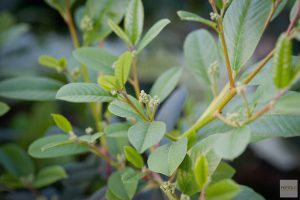BRING ON THE BIRDS: PITTOSPORUM VS. RHAMNUS
By Cassy Aoyagi: Both Pittosporum and Rhamnus will provide a berry-full screen of variable texture … but only Rhamnus is truly for the birds, bringing beneficial wildlife and music to your landscape.
Pittosporum
Despite being native to China and Japan, Pittosporum is heavily used in California gardens. In fact, Angelinos can readily find a Pittosporum to suit virtually every garden condition in area nurseries. Many like Pittosporum tenuifolium as a tall, graceful screen, while Pittosporum undulatum’s orange berries attract significant human interest.
While Pittosporum requires only moderate water, we consider it a candidate for exchange for two reasons. Pittosporum is:
- Highly Invasive. Pittosporum undulatum, in particular, tends to take liberties, volunteering itself throughout a garden until entire properties become Pittosporum wilderness.
- Attracts Less Wildlife. Not all Pittosporum berries attract birds, so, in many cases, the berries fall to the ground becoming a messy nuisance. When birds do eat the Pittosporum seeds, they spark further spread of this invasive plant.
Pittosporum has some nice uses; however, a very similar California native plant will do what its told and sing its heart out – or at least bring birds that will!
Rhombus Californica (aka Coffeeberry)
 Native to California and Oregon, Rhamnus thrives in variable habitats, from coastal ranges all the way to 7500 feet in the high Sierras. Like Pittosporum, Rhamnus also tolerates both shade and sun. Rhamnus California will filter sun and provide privacy as a large sprawling screen, while other varieties behave as low tidy shrubs and graceful ground covers. Rhamnus:
Native to California and Oregon, Rhamnus thrives in variable habitats, from coastal ranges all the way to 7500 feet in the high Sierras. Like Pittosporum, Rhamnus also tolerates both shade and sun. Rhamnus California will filter sun and provide privacy as a large sprawling screen, while other varieties behave as low tidy shrubs and graceful ground covers. Rhamnus:
- Uses slightly less water. It can take no water, but also tolerates garden conditions where water is more regular.
- Provides Foliage Variety. Rhamnus californica sports beautiful, clean, evergreen leathery leaves with inconspicuous flowers followed by red berries that turn to black, while another cultivated species with variegated leaves adds contrast to shady areas of woodland gardens.
- Stays Put. Where Pittosporum wanders, Rhamnus will stand its ground.
- Brings the Birds! Rhamnus is incredibly attractive to birds and nesters for food and shelter. Many native birds feast on Rhamnus, happily singing for their supper and ensuring the garden floor stays spic and span.
Ready to hear the sweet song of the natives? Rhamnus companions well with Juncus, columbine and other shade loving woodland plants.
For more guidance on where to plant big dry ones, see our past Wet-to-Dry Exchange articles.
